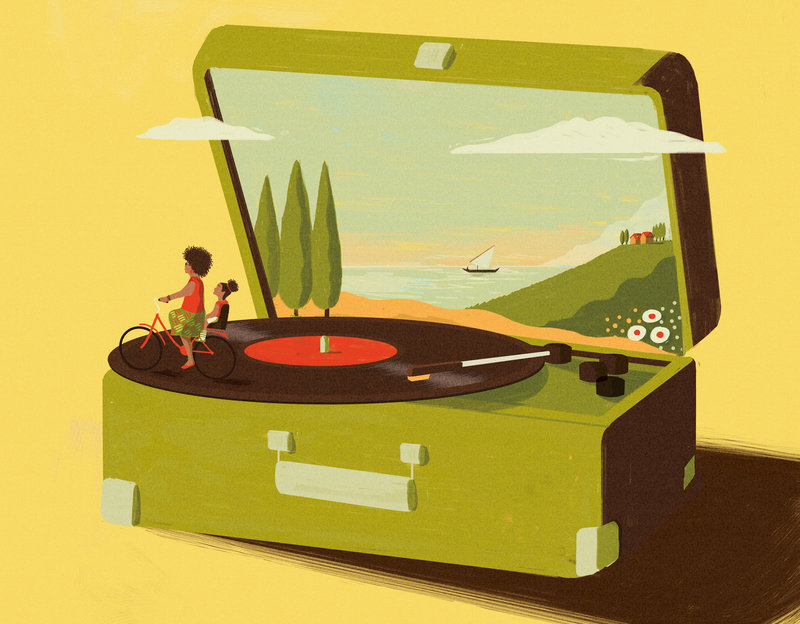The Surprising Benefit Of Moving And Grooving With Your Kid
by Shankar Vedantam
People who spend time with young children know firsthand the power of music.
It’s easy entertainment.
And any teacher who works in early childhood will tell s an assistant at a day care center in the late 2000s.
But there may be other ways — surprising ways — in which music plays a role in raising a human.
That’s a question that Cirelli is pursuing in her postdoctoral research in early childhood development at the University of Toronto, Mississauga.
“I find babies are so impressive. We can’t really ask them what they’re thinking. We have to come up with clever ways of figuring out what’s going on in their little brains,” she says.
One thing Cirelli is curious about: What makes young children behave in a pro-social way — taking actions that help others and benefit the group?
She invited a bunch of parents to bring their toddlers into her lab.
“We were specifically testing 14-month-old babies,” she says. “So they’re walking, not yet talking.”
These 14-month-olds said bye-bye to Mommy and Daddy and were then strapped into front-facing baby carriers worn by assistants in the study. The researchers turned on some music. Usually it was “Twist and Shout.”
And the person carrying the baby began to bounce.
“We would go down on one beat and then up,” says Cirelli.
So if you’re this baby, you’re strapped onto someone’s chest and you can’t see that person’s face. Instead, you’re looking in front of you at another person whom you’ve never seen before.
“The person facing the baby would either move in synchrony with how they were being bounced, or they would either move too quickly or too slowly so that their movements weren’t aligned with what the baby was experiencing,” says Cirelli.
After about 2 1/2 minutes, the bouncing stopped and the baby was removed from the carrier.
Next came the test.
“This person who had faced them and moved either in or out of sync with them would play little games with them; they would draw with markers or throw paper balls in a bucket,” says Cirelli.
Every now and then, the assistant who had faced the baby would drop a marker or ball and then pretend the object was out of reach.
“So she would reach pathetically for about 30 seconds,” says Cirelli, “and we’d look to see what the babies did in this really weird situation where this person they just met needs help but isn’t really asking for help.”
Cirelli found that babies who were bounced in sync with a dance partner were more likely to volunteer to help than babies who were bounced out of sync.
And it wasn’t just the bouncing. It was the music, too. Cirelli ran another experiment where there wasn’t any music. Instead, they played nature sounds, and the researchers bounced the babies in sync with the nature sounds.
Cirelli found that babies who bounced in sync with nature sounds were still more likely to help the assistants. But there was a higher fuss-out, meaning that the babies listening to nature sounds didn’t want to be held and bounced. They got upset. They didn’t want to continue bouncing. “Whereas the experiment with music in the background, they were much happier,” Cirelli says.
Moving together to the music created a connection — a connection that manifested itself through helpfulness.
Cirelli decided to look at another type of music used to forge connections — one that may be soothing.
Lullabyes.
Cirelli recruited 30 moms to come into the lab with their babies.
“They would be in a soundproof room, babies would be in a little highchair and mom would sit facing them,” she says.
Then the researchers measured stress levels for the mothers and children.
“So we use stickers on the bottom of the baby’s foot and on Mom’s fingertips. And what we were able to measure with this was their sweat gland activity,” Cirelli says.
The mothers were then asked to sing “Twinkle Twinkle Little Star” as a lullaby.
“When Mom sang in a soothing way, both Mom and baby’s arousal level decreased as the song progressed,” Cirelli says. “So what this is telling us is that lullabies are really working to calm not only the baby, but also mother.”
Now it’s not a surprise that lullabies are soothing to children. Most parents would likely agree based on their experience.
But those parents might also be holding the baby, rocking the baby.
In the experiment, there was no touching. “We wanted to see what the song is doing without tactile input,” Cirelli says.
And it definitely led to a reduction in stress.
But the main take-home lesson, says Cirelli, is that the lullaby also affected the mom. “We usually think of that unidirectional relationship: When Mom sings to baby, it’s to change the baby’s behavior,” Cirelli says. “But I think the really new interesting thing here is considering how it is also affecting the mom.”
